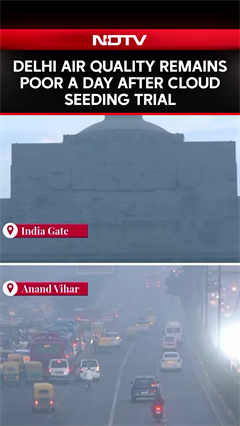- Home/
- World Stroke Day: Expert Decodes The Link Between Air Pollution And Stroke Risk
World Stroke Day: Expert Decodes The Link Between Air Pollution And Stroke Risk

World Stroke Day is observed on October 29 every year, aiming to raise awareness about stroke prevention, recognition, and treatment. The day serves as an opportunity to educate individuals about the symptoms of stroke, the factors that contribute to it, and the crucial role of timely treatment during an emergency. World Stroke Day also aims to promote healthy lifestyle choices, which can play a significant role in reducing stroke incidence. While high blood pressure, smoking, obesity, and poor cholesterol levels are well-known risk factors for a stroke, air pollution can also silently increase your risk. "Air pollution doesn't just affect the lungs; it can infiltrate directly into the body and harm the brain, raising the risk of stroke. The thing is, when we breathe in polluted air, small toxic particles called PM2.5 and nitrogen oxides enter the lungs and, by means of thin air sacs, get into the blood," said Dr. Kunal Bahrani, Clinical Director - Neurology, Marengo Asia Hospitals, Faridabad.
Air pollution and stroke risk
Research has indicated a link between air pollution and an increased risk of stroke. Fine particulate matter (PM2.5), ozone, and other pollutants can contribute to several health issues that elevate the risk of strokes, including:
1. Inflammation
Air pollution can lead to systemic inflammation, which is associated with numerous cardiovascular diseases, including stroke. "Polluted particles travel through the body, sparking inflammation and oxidative stress that damage blood vessels and make them more likely to form clots," mentioned Dr. Bahrani.
2. Atherosclerosis
Pollutants can contribute to the buildup of plaques in arteries, narrowing them and increasing the risk of blood clots that can result in a stroke. "In the bloodstream, noxious pollutants can constrict or clog the arteries that deliver blood to the brain. This can interrupt the flow of oxygen and nutrients to brain cells, and cause a stroke," Dr. Bahrani explained.
3. Hypertension
Exposure to high levels of air pollution is linked to increased blood pressure, which is a significant risk factor for stroke. "The long-term inhalation of air pollution can also elevate blood pressure, increase cholesterol deposition, and make the blood thicker, all of which add to stroke risk," he added.
4. Cardiovascular diseases
Long-term exposure to polluted air can exacerbate existing heart conditions and increase your risk.
"Research has indicated that people who live in cities with elevated air pollution levels are at increased risk of suffering from both ischemic (blocked blood flow) and hemorrhagic (bleeding) strokes. It is particularly dangerous in older adults, people with heart disease, diabetes, or high blood pressure," Dr. Bahrani explained.
Tips to lower stroke risk
"Shielding yourself from dirty air (wearing an N95 mask, operating an air purifier, and staying inside on smoggy days) and advocating for clean air policies could mitigate the covert but threatening effect that toxic fumes exert over your brain and health at large," he advised.
Some other tips to lower overall stroke risk:
1. Eat a healthy diet
Focus on consuming a balanced diet rich in fruits, vegetables, whole grains, and lean proteins while minimising saturated fats, trans fats, and sodium.
2. Exercise regularly
Engage in at least 150 minutes of moderate exercise each week, which can help control weight, reduce blood pressure, and improve overall heart health.
3. Control blood pressure
Regularly monitor blood pressure and keep it within a healthy range through diet, exercise, and medication if necessary.
4. Quit smoking
Smoking significantly increases the risk of stroke. If you are struggling to quit, seek medical help.
5. Limit alcohol intake
If you consume alcohol, do so in moderation.
6. Manage chronic conditions
Manage pre-existing health conditions like diabetes and heart disease to control your risk.
7. Reduce stress
Engage in stress-reducing activities like yoga, meditation, and hobbies for overall well-being.
Air pollution is a significant risk factor for multiple serious health conditions. Taking these proactive measures can help reduce stroke risk.
Disclaimer: This content including advice provides generic information only. It is in no way a substitute for a qualified medical opinion. Always consult a specialist or your own doctor for more information. NDTV does not claim responsibility for this information.
Latest Stories
- Wednesday October 29, 2025 , New Delhi
In a city gasping for clean air, Delhi's latest attempt at cloud seeding - a technique to induce artificial rain - has once again ended in disappointment.
- Indo-Asian News Service | Wednesday October 29, 2025 , New Delhi
The NHAI said it has taken proactive steps and issued a comprehensive Standard Operating Procedure to its field offices in Delhi-NCR to mitigate air pollution caused by highway construction and allied activities.
- Edited by Saikat Kumar Bose | Wednesday October 29, 2025 , New Delhi
Cloud seeding over Delhi for an entire winter would cost approximately Rs 25 crore, and this sum is a small portion of the budget to tackle the air pollution in the national capital, IIT Kanpur director Manindra Agrawal has told NDTV.
- Indo-Asian News Service | Wednesday October 29, 2025 , Islamabad
Pakistan's Lahore continues to remain at the top of global pollution charts with an AQI of more than 300 according to Swiss air quality monitor IQAir as smog covered the region, local media reported.
- Written by Varsha Vats | Wednesday October 29, 2025
Air pollution doesn't just affect the lungs; it can infiltrate directly into the body and harm the brain, raising the risk of stroke.
................................ Advertisement ................................
Latest Videos
Opinion
Opinion | Why Indians Have Just Given Up On Air Pollution CrisisTanushree Ganguly
Friday December 20, 2024While some may argue that people in Delhi are now more aware of air pollution than they were a decade back, my rebuttal would be that awareness does not mean that people are concerned.
Opinion | You Must Outrage Over Filthy Air More Than Once A YearJyoti Pande Lavakare
Tuesday December 10, 2024Delhi welcomed us with monsoon rains and mangos. We were home. Fast forward a couple of years, in the winter of 2012, I found myself in denial about something other parents, mostly expats, were calling toxic air.
Opinion | Delhi's Air Pollution Situation Is Like A Bad MarriageNishtha Gautam
Friday November 22, 2024On a good day, such as today, the AQI reading in Delhi is 407. We are jubilant at the sickly sunshine trickling through the slightly dissipated smog. At least its not 1600.
दिवाली... पराली... सियासी जुगाली!Ashwini kumar
Monday November 18, 2024दिल्ली-एनसीआर में प्रदूषण का समाधान तो आज तक मिला नहीं. हर साल चिंतित होकर हम-आप सांसों की तकलीफ के साथ-साथ दिल और ब्लड प्रेशर के मरीज भी क्यों बनें?
घर में कैद बुजुर्ग और हांफते लोग, दिल्ली की सांसों में घुला ये कैसा रोग?Nidhi Kulpati
Friday November 08, 2024हमारी हवा जहरीली हो रही है. गुरुवार की शाम को जब मैं इस मुद्दे पर लिखने बैठी तो AQI लगातार 400 पार जाकर दम घोंट रहा था. बहुत लोगों को यह मामला बोरिंग लगे, लेकिन जब आप अपने साथ काम करने वालों को खांसते-हांफते देखते-सुनते हैं, तो चिंता होने लगती है. सुबह उठते ही दरवाजे खिड़कियां खोलने के लिए डॉक्टर मना कर रहे हैं. बड़े बुजुर्गों के लिए तो मॉर्निंग वॉक बाहर की दुनिया से सीधे संपर्क का ज़रिया है, लेकिन डॉक्टर इसकी भी मनाही कर रहे हैं.


















